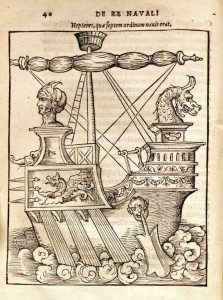Is there a food in North America more intrinsically linked with the landscape of the past and nostalgically intertwined with a holiday feast than the cranberry? From Cranberry Lakes in Nova Scotia, Cranberry River of West Virginia, Cranberry Pond in Sunderland, Massachusetts, the Cranberry Isles of Maine, Cranberry Mountain in New York, Cranberry Meadow in New Jersey, and many a Cranberry Bog dotting coastal areas, the plant deserves the appellation of First or Founding Fruit. It is one of the indigenous foods in North America widely cultivated today. The narratives of the places where the berries once grew wild and of the loss of these habitats can be recovered from historical sources.
Tag: Smithsonian Libraries

Amid the manuscripts, incunabula and early modern texts at the Dibner Library of the History of Science and Technology are two bright blue binders that don’t seem to quite fit, in every sense of the word. Too big for the shelf and too 20th century for the Dibner, don’t judge these books by their covers! In honor of National Comic Book Day we would like to highlight two of the Dibner’s most popular holdings—William Moulton Marston’s letters and scripts for the original Wonder Woman comic book series.
“George Sarton, a founder of the history of science as an academic discipline, argued that scholars should pay close attention to portraits. These images, he said, can give you ‘the whole man at once.’ With a ‘great portrait,’ Sarton believed, ‘you are given immediately some fundamental knowledge of him, which even the longest descriptions and discussions would fail to evoke.’ Sarton’s ideas led Bern Dibner to purchase portrait prints of men and women of science and technology. Many of these are now in the Smithsonian’s Dibner Library of the History of Science and Technology.” – Deborah Jean Warner, Curator, Physical Sciences Collection
A picture may tell 1000 words, but another 500 for context can add depth to the image. Follow this blog series to discover the people behind the portraits available online in the Scientific Identity collection.

Brewing and seafaring are mainstays of ancient human endeavors. Beer was first fermented by at least the 5th millennium BC in Mesopotamia. From the land between the Tigris and Euphrates Rivers of the Fertile Crescent, the grain beverage either traveled along trade routes or was spontaneously developed in other ancient civilizations (including Egyptian, Grecian, Roman, Norse, Aztec, Chinese) before landing in northern Europe in the early medieval period. Producing beer became a standard domestic chore in households, and later, on a slightly larger scale, in taverns and monasteries.
“George Sarton, a founder of the history of science as an academic discipline, argued that scholars should pay close attention to portraits. These images, he said, can give you ‘the whole man at once.’ With a ‘great portrait,’ Sarton believed, ‘you are given immediately some fundamental knowledge of him, which even the longest descriptions and discussions would fail to evoke.’ Sarton’s ideas led Bern Dibner to purchase portrait prints of men and women of science and technology. Many of these are now in the Smithsonian’s Dibner Library of the History of Science and Technology.”
– Deborah Jean Warner, Curator, Physical Sciences Collection
National Garden Month blasts off with zinnias, written by Robin Everly and Julia Blakely. Smithsonian Libraries, most days, is like a typical library system — we assist staff and visitors more »
The Smithsonian Libraries does not contain an overwhelming number of notable bookbindings in its collections. Unlike some other research institutions, fine or interesting covers are not a collecting focus or reason for acquiring a title. Many of our books have had a hard life, well-used over the decades by staff and researchers in the museums’ departments. These survivors have often been rebound in library buckram (sturdy but oh so boring) or been slapped with labels and barcodes (from an earlier time of library practice). So it is always a thrill to come across a striking specimen of an original binding.






